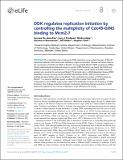DDK regulates replication initiation by controlling the multiplicity of Cdc45-GINS binding to Mcm2-7
Author(s)
De Jesús-Kim, Lorraine; Friedman, Larry J; Lõoke, Marko; Ramsoomair, Christian K; Gelles, Jeff; Bell, Stephen P; ... Show more Show less
DownloadPublished version (3.624Mb)
Publisher with Creative Commons License
Publisher with Creative Commons License
Creative Commons Attribution
Terms of use
Metadata
Show full item recordAbstract
© 2021, eLife Sciences Publications Ltd. All rights reserved. The committed step of eukaryotic DNA replication occurs when the pairs of Mcm2-7 replicative helicases that license each replication origin are activated. Helicase activation requires the recruitment of Cdc45 and GINS to Mcm2-7, forming Cdc45-Mcm2-7-GINS complexes (CMGs). Using single-molecule biochemical assays to monitor CMG formation, we found that Cdc45 and GINS are recruited to loaded Mcm2-7 in two stages. Initially, Cdc45, GINS, and likely additional proteins are recruited to unstructured Mcm2-7 N-terminal tails in a Dbf4-dependent kinase (DDK)-dependent manner, forming Cdc45-tail-GINS intermediates (CtGs). DDK phosphorylation of multiple phosphorylation sites on the Mcm2-7 tails modulates the number of CtGs formed per Mcm2-7. In a second, inefficient event, a subset of CtGs transfer their Cdc45 and GINS components to form CMGs. Importantly, higher CtG multiplicity increases the frequency of CMG formation. Our findings reveal molecular mechanisms sensitizing helicase activation to DDK levels with implications for control of replication origin efficiency and timing.
Date issued
2021Department
Massachusetts Institute of Technology. Department of Biology; Howard Hughes Medical InstituteJournal
eLife
Publisher
eLife Sciences Publications, Ltd